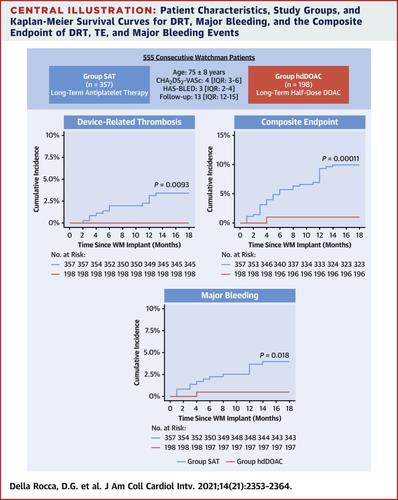JACC: Cardiovascular Interventions ( IF 11.3 ) Pub Date : 2021-10-13 , DOI: 10.1016/j.jcin.2021.07.031 Domenico G Della Rocca 1 , Michele Magnocavallo 2 , Luigi Di Biase 3 , Sanghamitra Mohanty 1 , Chintan Trivedi 1 , Nicola Tarantino 4 , Carola Gianni 1 , Carlo Lavalle 5 , Christoffel Johannes Van Niekerk 6 , Jorge Romero 4 , David F Briceño 4 , Mohamed Bassiouny 1 , Amin Al-Ahmad 1 , J David Burkhardt 1 , Veronica N Natale 7 , G Joseph Gallinghouse 1 , Armando Del Prete 8 , Giovanni B Forleo 9 , Javier Sanchez 1 , Dhanunjaya Lakkireddy 10 , Rodney P Horton 1 , Douglas N Gibson 6 , Andrea Natale 11

|
Objectives
This study evaluated the long-term efficacy of a standard antithrombotic strategy versus half-dose direct oral anticoagulation (DOAC) after Watchman implantation.
Background
No consensus currently exists on the selection of the most effective antithrombotic strategy to prevent device-related thrombosis (DRT) in patients undergoing endocardial left atrial appendage closure.
Methods
After successful left atrial appendage closure, consecutive patients were prescribed a standard antithrombotic strategy (SAT) or long-term half-dose DOAC (hdDOAC). The primary composite endpoint was DRT and thromboembolic (TE) and bleeding events.
Results
Overall, 555 patients (mean age 75 ± 8 years, 63% male; median CHA2DS2-VASc [congestive heart failure, hypertension, age ≥75 years, diabetes mellitus, prior stroke or transient ischemic attack or thromboembolism, vascular disease, age 65-74 years, sex category] score 4 [interquartile range (IQR): 3-6]; median HAS-BLED [hypertension, abnormal renal or liver function, stroke, bleeding, labile international normalized ratio, elderly, drugs or alcohol] score 3 [IQR: 2-4]) were included. Patients were categorized into 2 groups (SAT: n = 357 vs hdDOAC: n = 198). Baseline clinical characteristics were similar between groups. The median follow-up duration was 13 months (IQR: 12-15 months). DRT occurred in 12 (2.1%) patients, all in the SAT group (3.4% vs 0.0%; log-rank P = 0.009). The risk of nonprocedural major bleeding was significantly more favorable in the hdDOAC group (0.5% vs. 3.9%; log-rank P = 0.018). The rate of the primary composite endpoint of DRT and TE and major bleeding events was 9.5% in SAT patients and 1.0% in hdDOAC patients (HR: 9.8; 95% CI: 2.3-40.7; P = 0.002).
Conclusions
After successful Watchman implantation, long-term half-dose DOAC significantly reduced the risk of the composite endpoint of DRT and TE and major bleeding events compared with a standard, antiplatelet-based, antithrombotic therapy.
中文翻译:

左心耳封堵后半剂量直接口服抗凝与标准抗血栓治疗
目标
本研究评估了 Watchman 植入后标准抗血栓策略与半剂量直接口服抗凝 (DOAC) 的长期疗效。
背景
目前尚无关于选择最有效的抗血栓策略来预防心内膜左心耳封堵患者的器械相关血栓形成(DRT)的共识。
方法
在成功关闭左心耳后,连续患者被规定标准抗血栓形成策略 (SAT) 或长期半剂量 DOAC (hdDOAC)。主要复合终点是 DRT 和血栓栓塞 (TE) 和出血事件。
结果
总体而言,555 名患者(平均年龄 75 ± 8 岁,63% 男性;中位 CHA 2 DS 2 -VASc [充血性心力衰竭、高血压、年龄≥75 岁、糖尿病、既往中风或短暂性脑缺血发作或血栓栓塞、血管疾病、年龄 65-74 岁,性别类别] 得分 4 [四分位距 (IQR):3-6];中位 HAS-BLED [高血压、肾或肝功能异常、中风、出血、不稳定的国际标准化比率、老年人、药物或酒精] 得分 3 [IQR: 2-4]) 被包括在内。患者分为两组(SAT:n = 357 vs hdDOAC:n = 198)。两组的基线临床特征相似。中位随访时间为 13 个月(IQR:12-15 个月)。12 名 (2.1%) 患者发生 DRT,均在 SAT 组(3.4% vs 0.0%;对数秩P = 0.009)。hdDOAC 组的非手术性大出血风险明显更高(0.5% 对 3.9%;对数秩P = 0.018)。SAT 患者中 DRT 和 TE 和大出血事件的主要复合终点发生率为 9.5%,hdDOAC 患者为 1.0%(HR:9.8;95% CI:2.3-40.7;P = 0.002)。
结论
在成功植入 Watchman 后,与基于抗血小板的标准抗血栓治疗相比,长期半剂量 DOAC 显着降低了 DRT 和 TE 复合终点以及大出血事件的风险。


























 京公网安备 11010802027423号
京公网安备 11010802027423号